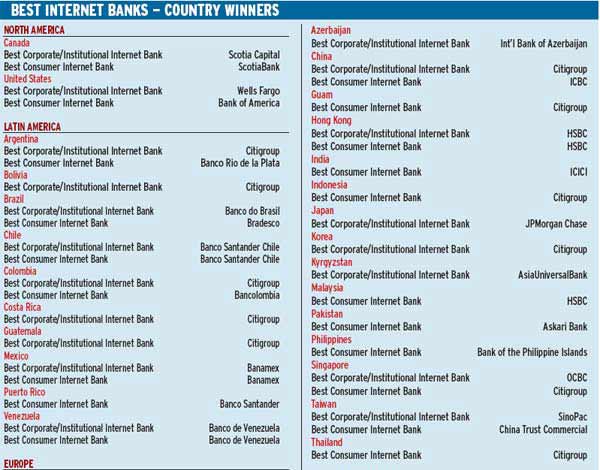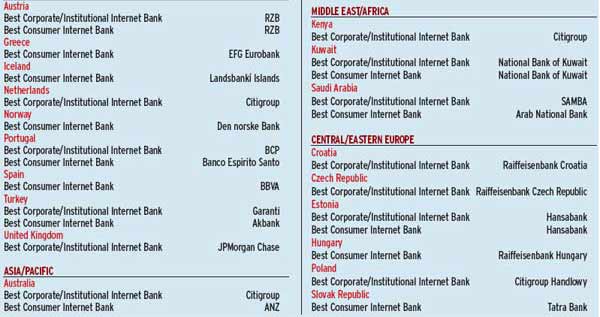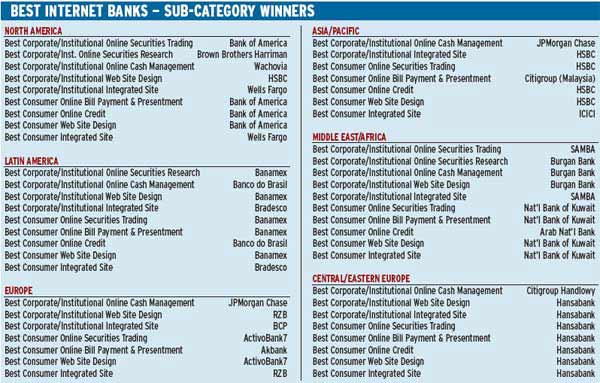In the first of a two-part serie s , Global Finance identifies the best online c orpor and consumer banks by country and product or service category
B y A dam R ombel

|
It is already almost a decade since Internet banking services first sprang up en masse. Consumer and corporate use of the medium to manage accounts and conduct transactions continues to growthough not quite as fast as during the early days. As it matures,the global Internet banking market is beginning to show some clear trends.
Internet Banking Boosted by Crises
Although Internet penetration growth rates remain steady,rates of adoption for online banking continue to increase in many markets, especially emerging markets.Outside events, such as [political or] market shocks, can spur even faster growth, says Benton Moyer, with the global consulting firm Neoris. One example Moyer points to is the outbreak of SARS in Asia,which caused an overall increase in online usage, as people were afraid to step out in public, and also boosted online banking.And during Argentinas financial crisis, many banks boosted services online in order to provide an alternative to waiting in daylong lines to withdraw money.
Banks Focusing on Privacy and Security
Increasing regulatory and media attention on privacy, identity theft and cyber terrorism is prompting banks to beef up their security systems and privacy policies. In Latin America, for example, the latest round of new, customized Internet offerings for corporate/institutional bank customers has arrived in tandem with banks upgrading their security platforms, online banking consultants say.
Online Applications Change Business Processes
Corporate clients are clamoring for online services that go beyond account information and transactions and ac-tually change business processes to make them more ef-ficient. They increasingly seek online offerings, such as workflow management processing solutions, that pre-sent them with a fundamentally better way of operating. They also want services that improve previously ineffi-cient business processesforeign exchange, payments and trade settlement,for examplesaving them time and money. Providing these services allows banks to leverage the Internet to strengthen their relationships with im-portant corporate customers and keep them from switching to a competitor, say consultants.
Internet banking has made the most headway and is reaching critical mass among corporate and institutional customers in cash management. For example, leading banks report usage rates topping 70% or 80% for cash management offerings. The banks have spent a lot of money to get these services right and to please demand-ing corporate clients. Strong cash management offerings allow a treasurer to check a balance, see if a payment is missing, initiate the payment and get a confirmation in one click on one screen. Customization allows corporate users to tailor their cash-management-reporting template to be on alert for certain balance thresholds and to exe-cute transactions automatically. Straight-through process-ing (STP) is also starting to gather steam.STP is the seam-less electronic processing of tradesbe they FX, fixed-income or equityfrom order entry to routing and execution. Corporate clients are increasingly demanding STP trading solutions to help reduce costs and enhance return on investment by executing and clearing transac-tions more quickly.


Leading Online Services Share Attributes
What many of the best Web offerings have in com-mon is that they are well organized, integrated and consistent; save time and money for clients, as well as the banks themselves; and foster customer loyalty. Successful online banks also use the medium to get their clients to buy as many as five products or ser-vices from them instead of the two or three that is commonplace.
THE AWARDS: HOW THEY WORK
This is the fourth year that Global Finance has set out to identify and honor the most successful and innovative providers of online banking services to corporate/institutional customers and to consumers. In the first round of competition, winners were selected for Best Corporate/Institutional Internet Banks and Best Consumer Internet Banks in individual countries. Awards were also made for regional winners in functional sub-categories such as Online Cash Management, Web Site Design and Integrated Site.
Winners were chosen from entries evaluated by a word-class judging panel comprised of representatives from the consulting firms Bearing Point, Deloitte & Touche, Logica, Neoris and Tata Infotech. Global Finance editors were responsible for final selection of winners and in the first round made 65 country-level awards to banks in 46 different countries and 50 awards for regional winners in 10 functional sub-categories. A number of banks won multiple awards, including Banamex, Bank of America, Citigroup, Hansabank, SAMBA and Wells Fargo.
Only banks that entered the competition were considered for awards, and awards were given only in those regions, countries and categories in which there were entries. The number of banks entering doubled from last year.
Winning banks were selected on the basis of strength of strategy for attracting and servicing online customers, success in getting clients to use Web offerings, growth of online customer base, breadth of products offered, evidence of tangible benefits gained from Internet initiatives, and Web site design and functionality. Sub-category winners, such as Best Online Cash Management, were selected based on the relative strength of those products and services.
Awards for Regional and Global Best Corporate/Institutional Internet Banks and Best Consumer Internet Banks as well as Global sub-category winners will be made at an October 16 awards ceremony in New York and published in the December issue of the magazine.
AR

|


